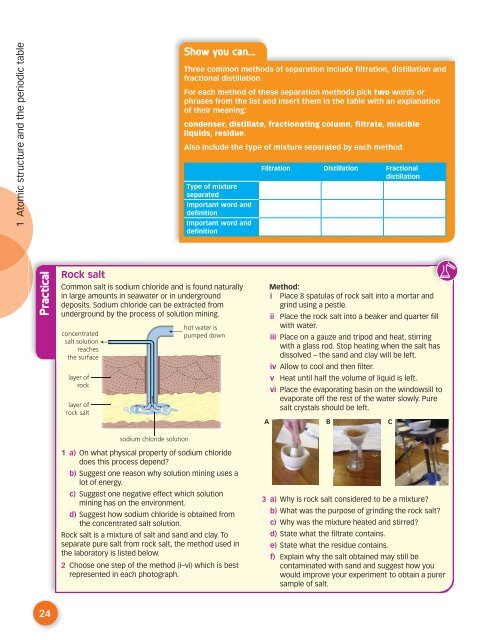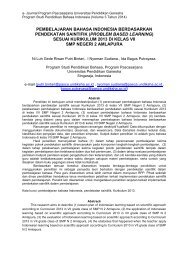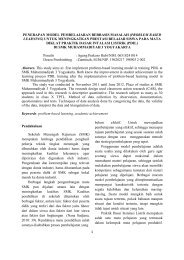You also want an ePaper? Increase the reach of your titles
YUMPU automatically turns print PDFs into web optimized ePapers that Google loves.
1 Atomic structure and the periodic table<br />
Show you can...<br />
Three common methods of separation include filtration, distillation and<br />
fractional distillation.<br />
For each method of these separation methods pick two words or<br />
phrases from the list and insert them in the table with an explanation<br />
of their meaning:<br />
condenser, distillate, fractionating column, filtrate, miscible<br />
liquids, residue.<br />
Also include the type of mixture separated by each method.<br />
Type of mixture<br />
separated<br />
Important word and<br />
definition<br />
Important word and<br />
definition<br />
Filtration Distillation Fractional<br />
distillation<br />
Practical<br />
Rock salt<br />
Common salt is sodium chloride and is found naturally<br />
in large amounts in seawater or in underground<br />
deposits. Sodium chloride can be extracted from<br />
underground by the process of solution mining.<br />
concentrated<br />
salt solution<br />
reaches<br />
the surface<br />
layer of<br />
rock<br />
layer of<br />
rock salt<br />
sodium chloride solution<br />
hot water is<br />
pumped down<br />
1 a) On what physical property of sodium chloride<br />
does this process depend?<br />
b) Suggest one reason why solution mining uses a<br />
lot of energy.<br />
c) Suggest one negative effect which solution<br />
mining has on the environment.<br />
d) Suggest how sodium chloride is obtained from<br />
the concentrated salt solution.<br />
Rock salt is a mixture of salt and sand and clay. To<br />
separate pure salt from rock salt, the method used in<br />
the laboratory is listed below.<br />
2 Choose one step of the method (i–vi) which is best<br />
represented in each photograph.<br />
Method:<br />
i Place 8 spatulas of rock salt into a mortar and<br />
grind using a pestle.<br />
ii Place the rock salt into a beaker and quarter fill<br />
with water.<br />
iii Place on a gauze and tripod and heat, stirring<br />
with a glass rod. Stop heating when the salt has<br />
dissolved – the sand and clay will be left.<br />
iv Allow to cool and then filter.<br />
v Heat until half the volume of liquid is left.<br />
vi Place the evaporating basin on the windowsill to<br />
evaporate off the rest of the water slowly. Pure<br />
salt crystals should be left.<br />
A B C<br />
3 a) Why is rock salt considered to be a mixture?<br />
b) What was the purpose of grinding the rock salt?<br />
c) Why was the mixture heated and stirred?<br />
d) State what the filtrate contains.<br />
e) State what the residue contains.<br />
f) Explain why the salt obtained may still be<br />
contaminated with sand and suggest how you<br />
would improve your experiment to obtain a purer<br />
sample of salt.<br />
24





